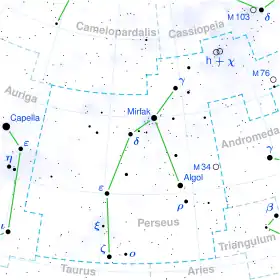 | |
| Observation data Epoch J2000 Equinox J2000 | |
|---|---|
| Constellation | Perseus |
| Right ascension | 04h 21m 33.16651s[1] |
| Declination | 46° 29′ 55.9591″[1] |
| Apparent magnitude (V) | 4.80[2] |
| Characteristics | |
| Spectral type | B4IV[3] |
| U−B color index | −0.52[4] |
| B−V color index | −0.03[4] |
| Variable type | SPB[5] |
| Astrometry | |
| Radial velocity (Rv) | +7.30[6] km/s |
| Proper motion (μ) | RA: +21.482[1] mas/yr Dec.: −34.832[1] mas/yr |
| Parallax (π) | 6.8517 ± 0.2700 mas[1] |
| Distance | 480 ± 20 ly (146 ± 6 pc) |
| Absolute magnitude (MV) | −1.42[7] |
| Details | |
| Mass | 5.9±0.1[8] M☉ |
| Radius | 3.98±0.49[7] R☉ |
| Luminosity | 779.8+213.3 −167.5[7] L☉ |
| Surface gravity (log g) | 3.93±0.09[7] cgs |
| Temperature | 16,720[9] K |
| Rotational velocity (v sin i) | 15[10] km/s |
| Age | 50.1±9.3[8] Myr |
| Other designations | |
| Database references | |
| SIMBAD | data |
53 Persei is a single[12] variable star in the northern constellation of Perseus. It has the Bayer designation d Persei, while 53 Persei is the Flamsteed designation. The star is visible to the naked eye as a faint, blue-white hued point of light with an apparent visual magnitude of 4.80.[2] It is located approximately 480 light years away from the Sun, as determined from parallax, and is drifting further away with a radial velocity of +7.3 km/s.[6]

This star has a stellar classification of B4IV,[3] and was the prototype of a class of variable stars known as slowly pulsating B stars.[14] It was one of the first mid-B type variable stars in the northern hemisphere to be studied.[5] The star undergoes non-radial pulsations with a primary period of 2.36 days. Observation of the star with the BRITE satellite revealed eight separate frequencies in the star's light curve.[5]
53 Persei is around 50[8] million years old with a projected rotational velocity of 15 km/s.[10] It has six[8] times the mass of the Sun and four[7] times the Sun's radius. The star is radiating 780[7] times the luminosity of the Sun from its photosphere at an effective temperature of 16,720 K.[9]
References
- 1 2 3 4 5 Brown, A. G. A.; et al. (Gaia collaboration) (August 2018). "Gaia Data Release 2: Summary of the contents and survey properties". Astronomy & Astrophysics. 616. A1. arXiv:1804.09365. Bibcode:2018A&A...616A...1G. doi:10.1051/0004-6361/201833051. Gaia DR2 record for this source at VizieR.
- 1 2 Anderson, E.; Francis, Ch. (2012). "XHIP: An extended hipparcos compilation". Astronomy Letters. 38 (5): 331. arXiv:1108.4971. Bibcode:2012AstL...38..331A. doi:10.1134/S1063773712050015. S2CID 119257644. Vizier catalog entry
- 1 2 Lesh, Janet Rountree (1968). "The Kinematics of the Gould Belt: An Expanding Group?". Astrophysical Journal Supplement. 17: 371. Bibcode:1968ApJS...17..371L. doi:10.1086/190179.
- 1 2 Mermilliod, J. C. (2006). "VizieR Online Data Catalog: Homogeneous Means in the UBV System (Mermilliod 1991)". VizieR On-line Data Catalog: II/168. Originally Published in: Institut d'Astronomie. 2168. Bibcode:2006yCat.2168....0M.Vizier catalog entry
- 1 2 3 Niemczura, E.; et al. (September 2017). Zwintz, Konnstanze; Poretti, Ennio (eds.). Photometric and spectroscopic variability of 53 Per. Second BRITE-Constellation Science Conference: Small satellites—big science, held 22–26 August 2016 in Innsbruck, Austria. Vol. 5. Warsaw, Poland: Polish Astronomical Society. pp. 217–218. Bibcode:2017sbcs.conf..217N.
- 1 2 Gontcharov, G. A. (2006). "Pulkovo Compilation of Radial Velocities for 35 495 Hipparcos stars in a common system". Astronomy Letters. 32 (11): 759–771. arXiv:1606.08053. Bibcode:2006AstL...32..759G. doi:10.1134/S1063773706110065. S2CID 119231169.
- 1 2 3 4 5 6 Briquet, M.; et al. (April 2007). "On the co-existence of chemically peculiar Bp stars, slowly pulsating B stars and constant B stars in the same part of the HR diagram". Astronomy and Astrophysics. 466 (1): 269–276. arXiv:astro-ph/0702111. Bibcode:2007A&A...466..269B. doi:10.1051/0004-6361:20066940. S2CID 16304587.
- 1 2 3 4 Tetzlaff, N.; et al. (2011). "A catalogue of young runaway Hipparcos stars within 3 kpc from the Sun". Monthly Notices of the Royal Astronomical Society. 410 (1): 190–200. arXiv:1007.4883. Bibcode:2011MNRAS.410..190T. doi:10.1111/j.1365-2966.2010.17434.x. S2CID 118629873. Vizier catalog entry
- 1 2 Zorec, J.; et al. (2009). "Fundamental parameters of B supergiants from the BCD system". Astronomy and Astrophysics. 501: 297–320. arXiv:0903.5134. Bibcode:2009A&A...501..297Z. doi:10.1051/0004-6361/200811147. S2CID 14969137.
- 1 2 Abt, Helmut A.; et al. (2002). "Rotational Velocities of B Stars". The Astrophysical Journal. 573 (1): 359–365. Bibcode:2002ApJ...573..359A. doi:10.1086/340590.
- ↑ "53 Per". SIMBAD. Centre de données astronomiques de Strasbourg. Retrieved 2019-07-18.
- ↑ Eggleton, P. P.; Tokovinin, A. A. (September 2008). "A catalogue of multiplicity among bright stellar systems". Monthly Notices of the Royal Astronomical Society. 389 (2): 869–879. arXiv:0806.2878. Bibcode:2008MNRAS.389..869E. doi:10.1111/j.1365-2966.2008.13596.x. S2CID 14878976.
- ↑ Huang, L.; Guo, Z.; Hao, J.; Percy, J. R.; Fieldus, M. S.; Fried, R.; Pavlovski, K.; Bozic, H.; Ruzic, Z.; Paparo, M.; Vetoe, B. (August 1994). "A Multisite UBV Photometric Campaign on 53 Persei in 1991 January". The Astrophysical Journal. 431: 850–869. Bibcode:1994ApJ...431..850H. doi:10.1086/174536. Retrieved 16 February 2022.
- ↑ Le Contel, J. M.; et al. (1989). "Spectral variations in 53 Per". Acta Astronomica. 39 (3): 227–234. Bibcode:1989AcA....39..227L.